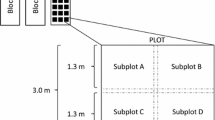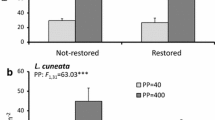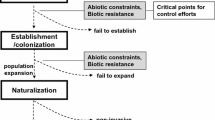Abstract
A pervasive problem in invasion ecology is the limited recovery of native communities following removal of invaders. Little evidence exists on the causes of variation in post-invasion recovery. In a 4-year experiment using 65 sets of matched plots, we imposed an invader removal treatment (with control) on heterogeneous grassland plots invaded or uninvaded by an aggressive recent arrival, Aegilops triuncialis (barb goatgrass). We tested the validity of plot matching using transplants and soil analyses. We analyzed the community-level correlates of invader impacts, removal treatment side effects, and community recovery, each defined in two ways: by compositional similarity to uninvaded plots, and by relative native species richness. Recovery of native species richness in invaded and treated plots was high (approaching 100 %) although recovery of composition was not high (median 71 % Bray–Curtis dissimilarity to uninvaded untreated plots). We measured resilience as the residuals of community recovery in models that controlled for invader impacts and removal treatment side effects. Compositional resilience was highest where the uninvaded communities had the least cover by other invaders in the same functional group as the focal invader. Richness resilience was highest where the uninvaded communities had the lowest native species richness. Our study suggests that the recovery of native species per se may be a more relevant goal than the recovery of the exact pre-invasion species composition of particular sites, particularly in cases where pre-invasion species composition included exotic species other than the focal invader.



Similar content being viewed by others
References
Abella SR (2014) Effectiveness of exotic plant treatments on National Park Service lands in the United States. Invasive Plant Sci Manag 7:147–163
Aigner PA, Woerly RJ (2011) Herbicides and mowing to control barb goatgrass (Aegilops triuncialis) and restore native plants in serpentine grasslands. Invasive Plant Sci Manag 4:448–457
Anderson MJ (2001) A new method for non-parametric multivariate analysis of variance. Austral Ecol 26:32–46
Anderson MJ, Ellingsen KE, McArdle BH (2006) Multivariate dispersion as a measure of beta diversity. Ecol Lett 9:683–693
Bush RT, Seastedt TR, Buckner D (2007) Plant community response to the decline of diffuse knapweed in a Colorado grassland. Ecol Restor 25:169–174
Byun C, de Blois S, Brisson J (2013) Plant functional group identity and diversity determine biotic resistance to invasion by an exotic grass. J Ecol 101:128–139
Calcagno V, de Mazancourt C (2010) Glmulti: an R package for easy automated model selection with (generalized) linear models. J Stat Softw 34:1–29
Case EJ, Harrison S, Cornell HV (2015) Do high-impact invaders have the strongest negative effects on abundant and functionally similar resident species? Funct Ecol (in press)
Chapin FS, Zavaleta ES, Eviner VT, Naylor RL, Vitousek PM, Reynolds HL, Hooper DU, Lavorel S, Sala OE, Hobbie SE, Mack MC, Diaz S (2000) Consequences of changing biodiversity. Nature 405:234–242
Cornelissen J, Lavorel S, Garnier E, Diaz S, Buchmann N, Gurvich D, Reich, P, Ter Steege H, Morgan H, Van Der Heijden M (2003) A handbook of protocols for standardised and easy measurement of plant functional traits worldwide. Austral J Bot 51:335–380
Denslow JD, d’Antonio CM (2005) After biocontrol: assessing indirect effects of insect releases. Biol Control 35:307–318
Diaz S, Hodgson JG, Thompson K, Cabido M, Cornelissen JHC, Jalili A, Montserrat-Marti G, Grime JP, Zarrinkamar F, Asri Y, Band SR, Basconcelo S, Castro-Diez P, Funes G, Hamzehee B, Khoshnevi M, Perez-Harguindeguy N, Perez-Rontome MC, Shirvany FA, Vendramini F, Yazdani S, Abbas-Azimi R, Borgaard A, Boustani S, Charles M, Dehghan M, de Torres-Espuny L, Falczuk V, Guerrero-Campo J, Hynd A, Jones G, Kowsary E, Kazemi-Saeed F, Maestro-Martinez M, Romo-Diez A, Shaw S, Siavash B, Villar-Salvador P, Zak MR (2004) The plant traits that drive ecosystems: evidence from three continents. J Veg Sci 15:295–304
Dickson TL, Mittelbach GG, Reynolds HL (2014) Height and clonality traits determine plant community responses to fertilization. Ecology 95:2443–2452
Drenovsky RE, Batten KM (2007) Invasion by Aegilops triuncialis (barb goatgrass) slows carbon and nutrient cycling in a serpentine grassland. Biol Invasions 9:107–116
Elmendorf S, Harrison S (2009) Temporal variability and nestedness in Californian grassland species composition. Ecology 90:1492–1497
Elmendorf S, Harrison S (2011) Is plant community diversity regulated over time? Contrasting results from experiments and long-term observations. Ecology 92:602–609
Eskelinen A, Harrison S (2013) Exotic plant invasions under enhanced rainfall are constrained by soil nutrients and competition. Ecology 95:682–692
Eviner VT (2004) Plant traits that influence ecosystem processes vary independently among species. Ecology 85:2215–2229
Fargione JE, Tilman D (2005) Diversity decreases invasion via both sampling and complementarity effects. Ecol Lett 8:604–611
Fargione J, Brown CS, Tilman D (2003) Community assembly and invasion: an experimental test of neutral versus niche processes. Proc Natl Acad Sci USA 100:8916–8920
Fernandez-Going BM, Anacker BL, Harrison SP (2012) Temporal variability in California grasslands: soil type and species functional traits mediate response to precipitation. Ecology 93:2104–2114
Harrison S (1999) Native and alien species diversity at the local and regional scales in a grazed Californian grassland. Oecologia 121:99–106
Harrison S, Cornell HV and Grace JB (2015) Does natural variation in diversity affect biotic resistance? J Ecol 103:1099–1106
Hooper DU, Dukes JS (2010) Functional composition controls invasion success in a California serpentine grassland. J Ecol 98:764–777
Hooper DU, Chapin FS, Ewel JJ, Hector A, Inchausti P, Lavorel S, Lawton JH, Lodge D, Loreau M, Naeem S, Schmid B, Setälä H, Symstad AJ, Vandermeer J, Wardle DA (2005) Effects of biodiversity on ecosystem functioning: a consensus of current knowledge. Ecol Monogr 75:3–35
Jäger H, Kowarik I (2010) Resilience of native plant community following manual control of invasive Cinchona pubescens in Galápagos. Restor Ecol 18:103–112
Jain SK (1982) Variation and adaptive role of seed dormancy in some annual grassland species. Bot Gaz 143:101–106
Johnson JB, Omland KS (2004) Model selection in ecology and evolution. Trends Ecol Evol 19:101–108
Kennedy TA, Naeem S, Howe KM, Knops JMH, Tilman D, Reich P (2002) Biodiversity as a barrier to ecological invasion. Nature 417:636–638
Levine JM (2000) Species diversity and biological invasions: relating local process to community pattern. Science 288:852–854
Levine JM, Vila M, d’Antonio CM, Dukes JS, Grigulis K, Lavorel S (2003) Mechanisms underlying the impacts of exotic plant invasions. Proc R Soc Lond 270:775–781
Levine JM, Adler PB, Yelenik SG (2004) A meta-analysis of biotic resistance to exotic plant invasions: biotic resistance to plant invasion. Ecol Lett 7:975–989
Longo G, Seidler TG, Garibaldi LA, Tognetti PM, Chaneton EJ (2013) Functional group dominance and identity effects influence the magnitude of grassland invasion. J Ecol 101:1114–1124
Lyons KG, Schwartz MW (2001) Rare species loss alters ecosystem function ‘invasion resistance’. Ecol Lett 4:358–365
Lyons KG, Maldonado-Leal BG, Owen G (2013) Community and ecosystem effects of buffelgrass (Pennisetum ciliare) and nitrogen deposition in the Sonoran Desert. Invasive Plant Sci Manag 6:65–78
Magnoli SM, Kleinhesselink AR, Cushman JH (2013) Responses to invasion and invader removal differ between native and exotic plant groups in a coastal dune. Oecologia 173:1521–1530
Marcantonio M, Rocchini D, Ottaviani G (2014) Impact of alien species on dune systems: a multifaceted approach. Biodivers Conserv 23:2645–2668
Molinari NA, d’Antonio CM (2013) Structural compositional and trait differences between native and non-native dominated grassland patches. Funct Ecol 28:745–754
Powell KI, Chase JM, Knight TM (2011) A synthesis of plant invasion effects on biodiversity across spatial scales. Am J Bot 98:539–548
Prach K, Hobbs RJ (2008) Spontaneous succession versus technical reclamation in the restoration of disturbed sites. Restor Ecol 16:363–366
Reid AM, Morin L, Downey PO, French K, Virtue JG (2009) Does invasive plant management aid the restoration of natural ecosystems? Biol Conserv 142:2342–2349
Reinecke MK, Pigot AL, King JM (2008) Spontaneous succession of riparian fynbos: is unassisted recovery a viable restoration strategy? S Afr J Bot 74:412–420
Richards SA (2005) Testing ecological theory using the information-theoretic approach: examples and cautionary results. Ecology 86:2805–2814
Rinella MJ, Maxwell BD, Fay PK, Weaver T, Sheley RL (2009) Control effort exacerbates invasive-species problem. Ecol Appl 19:155–162
Saito TI, Tsuyuzaki S (2012) Response of riparian vegetation to the removal of the invasive forb Solidago gigantea and its litter layer. Weed Biol Manag 12:63–70
Sandel B, Corbin JD (2010) Scale disturbance and productivity control the native-exotic richness relationship. Oikos 119:1281–1290
Seabloom EW, Williams JW, Slayback D, Stoms DM, Viers JH, Dobson AP (2006) Human impacts, plant invasion, and imperiled plant species in California. Ecol Appl 16:1338–1350
Selmants PC, Zavaleta ES, Pasari JR, Hernandez DL (2012) Realistic plant species losses reduce invasion resistance in a California serpentine grassland. J Ecol 100:723–731
Therneau T, Atkinson B, Ripley B (2015) rpart: recursive partitioning and regression trees. http://cran.r-project.org/web/packages/rpart/index.html
Thomson DM (2007) Do source-sink dynamics promote the spread of an invasive grass into a novel habitat? Ecology 88:3126–3134
Tognetti PM, Chaneton EJ (2012) Invasive exotic grasses and seed arrival limit native species establishment in an old-field grassland succession. Biol Invasions 14:2531–2544
Vila M, Espinar J, Hejda M, Hulme PE, Jarosik V, Maron JL, Pergl J, Schaffner U, Sun Y, Pysek P (2011) Ecological impacts of invasive alien plants: a meta-analysis of their effects on species communities and ecosystems. Ecol Lett 14:702–708
Wagner V, Nelson CR (2014) Herbicides can negatively affect seed performance in native plants: herbicide effects on seedling emergence. Restor Ecol 22:288–291
Westman WE (1978) Measuring the inertia and resilience of ecosystems. Bioscience 28:705–710
Wood SN (2011) Fast stable restricted maximum likelihood and marginal likelihood estimation of semiparametric generalized linear models. J R Stat Soc 73:3–36
Acknowledgments
We thank P. Aigner, C. Koehler, and R. Woerly for their logistical support of this project, and the UC Natural Reserve System for providing access and facilities at the study location.
Author information
Authors and Affiliations
Corresponding author
Electronic supplementary material
Below is the link to the electronic supplementary material.
Rights and permissions
About this article
Cite this article
Case, E.J., Harrison, S. & Cornell, H.V. After an invasion: understanding variation in grassland community recovery following removal of a high-impact invader. Biol Invasions 18, 371–380 (2016). https://doi.org/10.1007/s10530-015-1009-x
Received:
Accepted:
Published:
Issue Date:
DOI: https://doi.org/10.1007/s10530-015-1009-x




